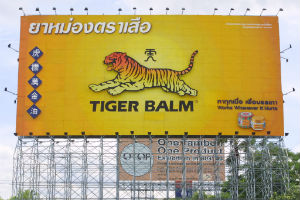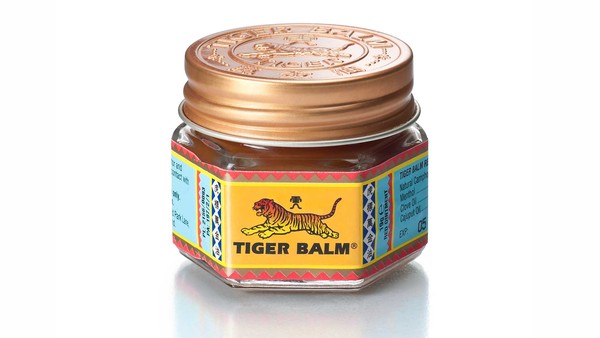Tiger Balm going back to Myanmar
Published: 11/01/2013 at 03:13 PM
Online news:
Famed for its soothing menthol smell and muscle pain-relieving properties, Tiger Balm is sold in more than 100 countries – but now the leaping tiger, based in Singapore for nearly a century, is returning to the country where it was invented.
Tiger Balm was created by the Aw brothers in what was Burma in the late 19th century. The Chinese businessmen made their fortune by selling the ointment from a shop in Rangoon (Yangon), before moving the business to Singapore in 1926.
Singapore-listed Haw Par Corporation, which owns the brand, is keen to take it back to the Myanmar market, where it has not been sold officially for decades.

Tiger Balm "works where it hurts" according to this 2003 Bangkok billboard advertisement. Now the brand is returning to its roots in neighbouring Myanmar. Photo by Pattanapong Hirunard.

An Ad in USA
“The reason why we are very keen on Myanmar is, of course, it’s our origin. Tiger Balm has gone out into the world, made a name for itself and now it’s coming back,” AK Han, the company’s executive director in charge of healthcare told the Financial Times.
Haw Par Corporation has already sent staff to Myanmar to find a distributor, which they did by creating a shortlist of companies from the labels of products already distributed in the country.
“With all due respect to the consultants, we’ve been in this business for a long time and we are in so many countries, so we are able to fish out the guys on the ground who can do the job and walk the talk,” Mr Han told the FT.
Mr Han added that confirmation that there is spending power in Myanmar to support consumer spending on products such as Tiger Balm came when the distributor organised parties in Yangon and Mandalay in September 2012 to mark the reintroduction of the product.
He said about 300 wholesalers, pharmacists and chemists turned up at each event in luxury cars such as Mercedes and Lexuses.
“That was when we knew we were right,” he said.
“These are the people who wake up commerce. Either they have their own trading organisations or they have their own trading links with, say, Thailand. They have wealth and they flaunt it.”
Mr Han remarked that there is “quite a layer of richer people” in Myanmar, who are not necessarily connected to the military.
Financial Times
http://www.bangkokpost.com/breakingnews/330365/tiger-balm-going-back-to-myanmar-roots
Published: 11/01/2013 at 03:13 PM
Online news:
Famed for its soothing menthol smell and muscle pain-relieving properties, Tiger Balm is sold in more than 100 countries – but now the leaping tiger, based in Singapore for nearly a century, is returning to the country where it was invented.
Tiger Balm was created by the Aw brothers in what was Burma in the late 19th century. The Chinese businessmen made their fortune by selling the ointment from a shop in Rangoon (Yangon), before moving the business to Singapore in 1926.
Singapore-listed Haw Par Corporation, which owns the brand, is keen to take it back to the Myanmar market, where it has not been sold officially for decades.

Tiger Balm "works where it hurts" according to this 2003 Bangkok billboard advertisement. Now the brand is returning to its roots in neighbouring Myanmar. Photo by Pattanapong Hirunard.

An Ad in USA
“The reason why we are very keen on Myanmar is, of course, it’s our origin. Tiger Balm has gone out into the world, made a name for itself and now it’s coming back,” AK Han, the company’s executive director in charge of healthcare told the Financial Times.
Haw Par Corporation has already sent staff to Myanmar to find a distributor, which they did by creating a shortlist of companies from the labels of products already distributed in the country.
“With all due respect to the consultants, we’ve been in this business for a long time and we are in so many countries, so we are able to fish out the guys on the ground who can do the job and walk the talk,” Mr Han told the FT.
Mr Han added that confirmation that there is spending power in Myanmar to support consumer spending on products such as Tiger Balm came when the distributor organised parties in Yangon and Mandalay in September 2012 to mark the reintroduction of the product.
He said about 300 wholesalers, pharmacists and chemists turned up at each event in luxury cars such as Mercedes and Lexuses.
“That was when we knew we were right,” he said.
“These are the people who wake up commerce. Either they have their own trading organisations or they have their own trading links with, say, Thailand. They have wealth and they flaunt it.”
Mr Han remarked that there is “quite a layer of richer people” in Myanmar, who are not necessarily connected to the military.
Financial Times
http://www.bangkokpost.com/breakingnews/330365/tiger-balm-going-back-to-myanmar-roots

